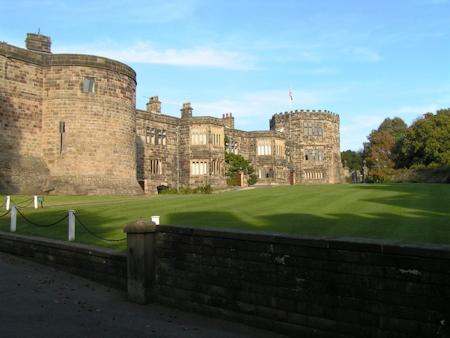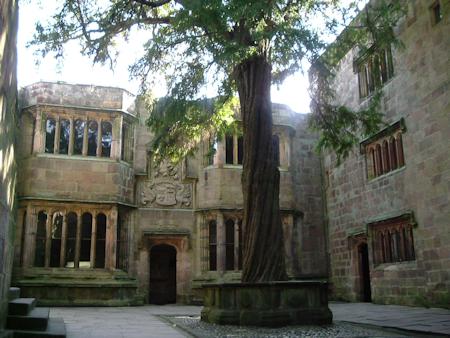
Skipton Castle
Skipton Castle sits in a strong defensive position on the cliff overlooking the Eller Beck. It is a superbly well-preserved castle and its keep is a notable example of Edwardian English military architecture.
The castle was originally constructed around 1090 by Robert de Romille. Romille was a Norman adventurer who was given the multiple estate at Bolton Abbey by William the Conqueror. The Romille line died out in the mid 13th Century and King Edward I bought out the baronacy and earldom for £100.
In 1310 King Edward II granted Skipton Castle and the Honour of Skipton in Craven to Robert de Clifford.
De Clifford Improvements
The de Clifford family were powerful and wealthy. By the time he received Skipton he had already distinguished himself at the siege of Caerlaverock Castle in 1300 and at the Battle of Falkirk in 1298.
Robert de Clifford immediately set about improving the existing Norman castle, but he fell at the Battle of Bannockburn in 1314. The work was probably taken over by his son Roger.
The outer bailey is no longer standing, but the outer gatehouse with its flanking towers is still there. The gatehouse dates from Roberts' reconstruction, but with some Tudor modifications.
Just beyond the gatehouse lies the keep. The keep at Skipton is a shell keep with 6 closely-spaced drum towers. The north side is flat against the edge of the cliff and it has the medieval domestic block with kitchens, the main hall and the solar.
Wars of the Roses
During the Wars of the Roses two members of the Clifford family where fought and died on the Lancastrian side. John Clifford, 9th Baron de Clifford was attainted for killing the king's brother and his lands and titles were forfeit to the Crown.
His son, Henry Clifford, was taken from his home at Skipton Castle aged just 7 and put into hiding for his own protection. When King Richard III lost the Battle of Bosworth the attainder was lifted by King Henry VII and he was able to return home.
Henry Clifford, 10th Baron de Clifford was known as the Shepherd Lord because of his peaceful demeanour and the long years he spent hiding in the countryside.
He added the east wing to Skipton, along with a number of new windows in the courtyard.
During the English Civil War, Skipton Castle was firmly on the Royalist side. It suffered a three-year siege until it finally surrendered in December 1645.
After the surrender Cromwell ordered the roofs to be removed. After the war, Lady Anne Clifford restored the castle and made a few modifications. At the tops of the towers the junction between the solid military walls and her thin masonry is clear.
The Conduit Court in the centre of the castle is dominated by a yew tree which she planted in 1659. It's there to commemorate the restoration of the castle after the war.
Lady Anne was the last Clifford to live at Skipton and it passed through a number of owners. In the 16th and 17th centuries a new staircase and further domestic areas were added.
The castle today is still in private ownership, but it is open as a visitor attraction and wedding venue. There are also a range of events during the summer months.
The castle has a shop, tearooms, a picnic area and corporate conference facilities. The castle welcomes school and youth groups and can offer interactive guided tours and teachers' materials.
Status: Visitor Attraction / Event Venue / Corporate Hospitality
Owner: Fattorini family
Tel: +44 1756 792442
Email: info@skiptoncastle.co.uk
Website: www.skiptoncastle.co.uk
Opening Times: Open Daily Summer Mon-Sat 10am to 6pm Sun 12pm to 6pm, Winter Mon-Sat 10am to 4pm Sun 12pm to 4pm


Skipton Castle living quarters

Conduit Court and the ancient Yew tree